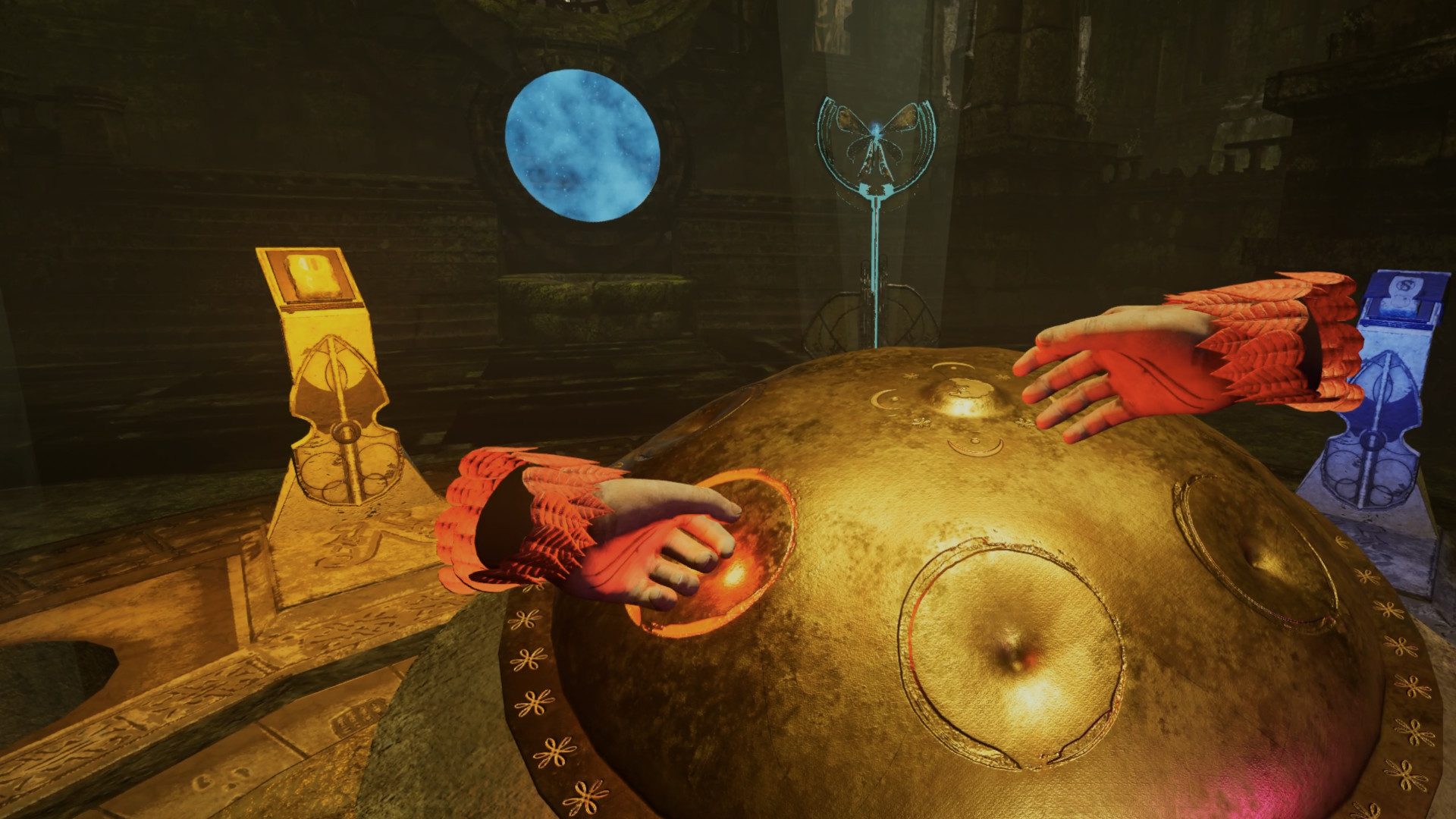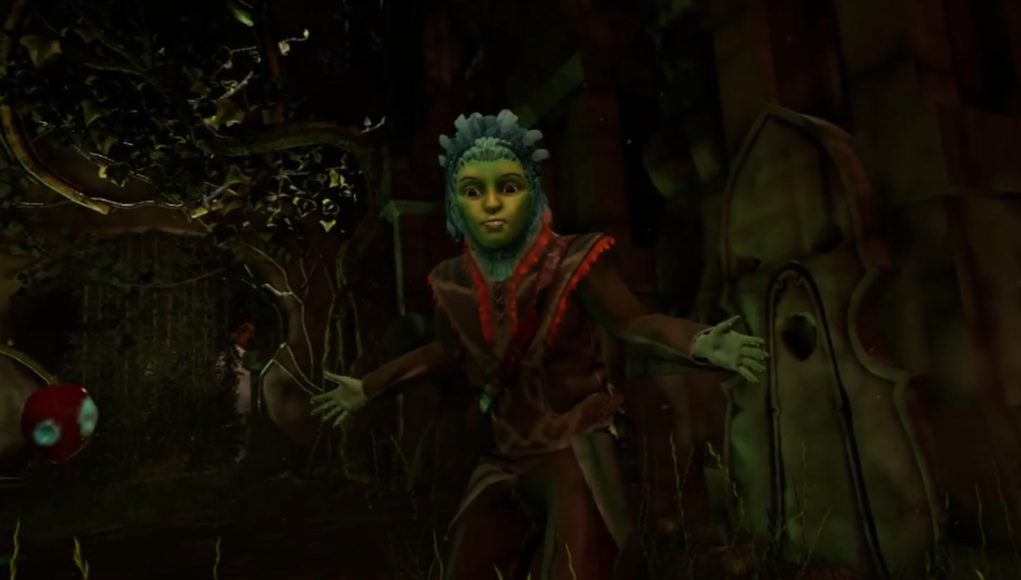Rhythm of the Universe: Ionia is a VR adventure that promises to take you to a fantastical world filled with musical flora and fauna. Despite some earnest attempts at worldbuilding, the end result is a thin and superficial theme park ride that bears a fleeting resemblance to its flashy promo trailer.
Rhythm of the Universe: Ionia Details:
Available On: Oculus Quest, SteamVR, PSVR
Price: $15
Developer: ROTU
Release Date: September 23rd, 2021
Reviewed On: Oculus Quest 2 via Link
Gameplay
I typically don’t frontload reviews with gameplay length because that’s not always a reliable metric to determine whether something is worth playing or not. For example, the Vader Immortal series are only about an hour-long per episode, but are a shining example of what happens when you put quality over quantity. Each of them also have discrete light saber dojos where you can level up your skills against waves of enemies, which does a good job of rounding out a short but sweet encounter with the storied Star Wars universe. I’m not directly comparing Ionia and Vader Immortal here, I’m just using it as an example of why gameplay length isn’t the most important factor.
Still, I think it bears mentioning ahead of my breakdown that Rhythm of the Universe: Ionia is a 45-minute experience. And if it were a truly enjoyable 45 minutes, this is where I might soften the blow. But really, Ionia feels more like a vertical slice of gameplay from 2016 than a honest to goodness fleshed-out game from 2021. Its cinematic pretense and claim to “push the limits of PC VR” simply aren’t backed up by a cogent story, fun or clever puzzles, real exploration, consistently good graphics—basically the whole gamut of what we expect from VR games nowadays.

Ionia puts heavy focus on its music-based puzzles, although there are really only around five instances when you actually play an instrument, and those moments act more as one-off hurdles on your way to the next block of exposition, served up by your sister Allegra.
Allegra spends so much time talking and guiding you through the whole game that I never once felt like the main character. I’m called on to save the world in a flashy 2D cutscene before the game begins and only after having played the whole game do I have the remotest idea why.
It’s a shame that music-based puzzles are only one-off events, and don’t offer more structured engagement. The different puzzles are direct analogues to real-world instruments, like the xylophone and the handpan, a new-age instrument that sounds similar to a steel drum, but none of them take the opportunity to teach you anything besides hitting a few random notes. Most of the time Allegra queues you to hit the right notes and then you’re off to the next easily resolved calamity or theme park-style room transition.
Worldbuilding is probably Ionia’s most redeeming feature, and that’s really not saying a lot. There are supposedly a few more areas of the island that (if ROTU continues as a series) will take us in later episodes, but outside of exposition the game offers very little in terms of storytelling in its guided one-way journey through the game’s five chapters. Why am I here? Where am I going? What’s the Harva? Who are the Tritones? All of that is doled out essentially near the end, and to be honest it felt like I had just finished a demo by the time the credits rolled.
So in the end, Ionia doesn’t really live up to the on-paper manifesto it sets out for itself. It wants to offer up a smorgasbord of VR interaction with things like climbing, playing instruments, being sucked into cinematic sequences—and none of it feels like it pays off, or offers more than a momentary distraction.
Immersion
For all its promises of exploration and wonder, Ionia doesn’t seem content with letting its players explore or experience the world naturally. Although the default teleportation movement can be turned off in the settings in favor of a more immersive smooth forward locomotion, the game is riddled with moments when you aren’t allowed to move. You might call these ‘immersive cutscenes’, where you’re forcibly locked in place to marvel at a broad and open area teeming with life you never get to explore underlined with another thick slice of exposition. Trying to move during the many immersive cutscene elicits an annoying red ‘X’ in the corner of your field of view.
As for exploration, a good portion of the game features climbing. Climbable areas are highlighted yellow and lack a sense of tactility, as there’s no haptic feedback to let you know you’ve locked on or not.
I feel like all climbable areas must necessarily be marked in florescent yellow because the game’s dark green/brown color palette simply doesn’t provide for enough visual contrast.
Although visuals are sometimes muddy, at times Ionia’s level design can feel expertly produced. An inconsistent level of polish is endemic throughout the game though, with moments of curiosity destroyed by falling out of the world whilst climbing a staircase, or seeing an animal, called an Ocarina, completely invert its head within its body. I wasn’t hunting for bugs either, just tossing a bit of fruit to a hungry animal.
This was already the third bug I encountered in the PC version of the game. To fix it, I had to teleport inside his body and blindly grab at the berry and teleport out, something that destroys any sense of immersion you might have built up. Bugs happen, but I shouldn’t be tasked with logging them, especially when they’re so blatant, and neither should you.
As you would guess, object interaction is pretty lame since nothing in the world appears to be physics-based. You can easily put your hand through anything, including interactive objects. The only hard limit is the ability to look through walls, which is obscured by a black shader. There’s no inventory to speak of since there aren’t any key items or collectibles.
You can exit and restart chapters at will, although you’ll have to start from the beginning and replay the entire thing. You can’t change settings without exiting the chapter, so you should have absolutely everything set before playing.
Comfort
Ionia features an acceptable number of comfort features, including variable snap-turn and teleportation. It doesn’t have a dedicated seated mode though, so you’ll need to stand or somehow adjust your view in-platform.
There are a few theme park-style ride sequences, however these are mostly tame, and usually go in straight lines at consistent speeds.
ROTU: Ionia Comfort Settings – September 23rd, 2021 |
|
Turning |
|
| Artificial turning | ✔ |
| Smooth-turn | ✖ |
| Adjustable speed | n/a |
| Snap-turn | ✔ |
| Adjustable increments | ✔ |
Movement |
|
| Artificial movement | ✔ |
| Smooth-move | ✖ |
| Adjustable speed | n/a |
| Teleport-move | ✔ |
| Blinders | ✔ |
| Adjustable strength | ✔ |
| Head-based | ✔ |
| Controller-based | ✔ |
| Swappable movement hand | n/a |
Posture |
|
| Standing mode | ✔ |
| Seated mode | ✖ |
| Artificial crouch | ✖ |
| Real crouch | ✔ |
Accessibility |
|
| Subtitles | ✔ |
| Languages | English, German, Spanish, French, Chinese |
| Alternate audio | ✖ |
| Adjustable difficulty | ✖ |
| Two hands required | ✔ |
| Real crouch required | ✖ |
| Hearing required | ✖ |
| Adjustable player height | ✖ |







